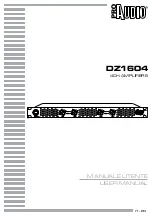
If you have a concern that the output impedance may be too high to properly drive the
capacitance of a cable, keep in mind that that 1000 ohms still will allow bandwidth to 160
kHz into 1000 pF of capacitance. The maximum output impedance only occurs at the
volume control maximum, and quickly goes to a low figure below the maximum level position.
In typical operation, the output impedance will be between 100 and 300 ohms.
The sixteen relays which operate the level control allow greater than 48 dB range and are
driven by a microcontroller which reads the optical encoder which serves as a front panel
volume control. In this manner tracking of the volume of the two balanced channels is
possible with an accuracy unavailable on any ordinary volume control, assuring precise level
steps and high common mode rejection in balanced circuits.
The relays may lack the high speed switching characteristic of the solid-state state switches
used by other preamplifiers, but they also have none semiconductor distortions and noise
which accompany analog gates and voltage controlled amplifiers. If it bothers you to hear
the click of the relays as the level is adjusted, just consider the artifacts you won’t hear after
the level is adjusted.
Adjustment to optimize the level controls against an input level is easy. Select the most
important input. Set the Right and Left level controls at minimum gain (counterclockwise)
and adjust the Master level control to as high as you will want to listen. If you don’t have
enough gain, then increase the levels on the Left and Right level controls until you do.
For maximum performance, the idea is to keep the Master control as clockwise as possible,
and the Left and Right level controls as counterclockwise as possible.
In other words, go ahead and turn it up.
This is not a big deal to worry about, but the ability to get the most performance is available
in this preamp in a manner not seen elsewhere, and you will want to take advantage of it.
Using the remote control is very simple. Point it at the preamplifier and press one of the four
buttons on the remote.
The side to side buttons will change the input selection.
The top to bottom buttons will change the master level.
The end.
Product Philosophy and Design Theory
When I started designing amplifiers 25 years ago, solid state amplifiers had just achieved a
firm grasp on the market. Power and harmonic distortion numbers were king, and the largest
audio magazine said that amplifiers with the same specs sounded the same.
We have heard Triodes, Pentodes, Bipolar, VFET, Mosfet, TFET valves, IGBT, Hybrids,
THD distortion, IM distortion, TIM distortion, phase distortion, quantization, feedback,




























